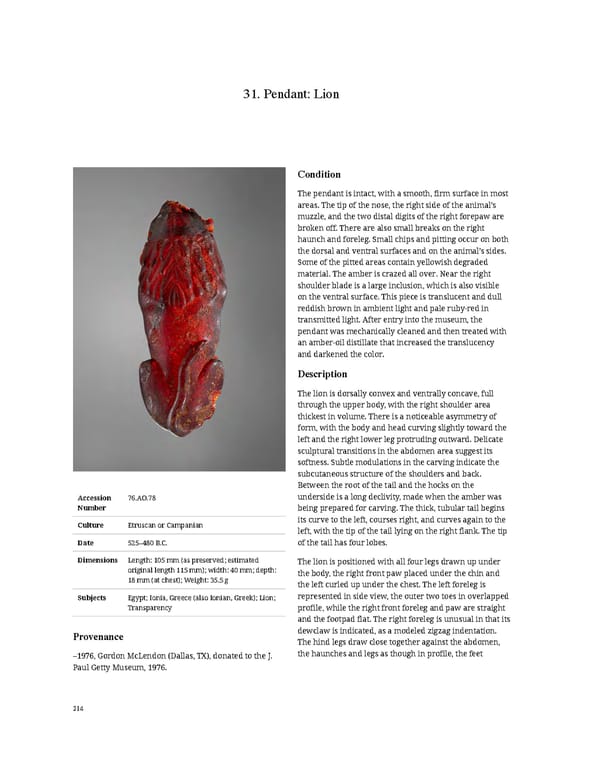31. Pendant: Lion Condition The pendant is intact, with a smooth, firm surface in most areas. The tip of the nose, the right side of the animal’s muzzle, and the two distal digits of the right forepaw are broken off. There are also small breaks on the right haunch and foreleg. Small chips and pitting occur on both the dorsal and ventral surfaces and on the animal’s sides. Some of the pitted areas contain yellowish degraded material. The amber is crazed all over. Near the right shoulder blade is a large inclusion, which is also visible on the ventral surface. This piece is translucent and dull reddish brown in ambient light and pale ruby-red in transmitted light. After entry into the museum, the pendant was mechanically cleaned and then treated with an amber-oil distillate that increased the translucency and darkened the color. Description The lion is dorsally convex and ventrally concave, full through the upper body, with the right shoulder area thickest in volume. There is a noticeable asymmetry of form, with the body and head curving slightly toward the left and the right lower leg protruding outward. Delicate sculptural transitions in the abdomen area suggest its softness. Subtle modulations in the carving indicate the subcutaneous structure of the shoulders and back. Between the root of the tail and the hocks on the Accession 76.AO.78 underside is a long declivity, made when the amber was Number being prepared for carving. The thick, tubular tail begins Culture Etruscan or Campanian its curve to the left, courses right, and curves again to the left, with the tip of the tail lying on the right flank. The tip Date 525–480 B.C. of the tail has four lobes. Dimensions Length: 105 mm (as preserved; estimated The lion is positioned with all four legs drawn up under original length 115 mm); width: 40 mm; depth: the body, the right front paw placed under the chin and 18 mm (at chest); Weight: 35.5 g the left curled up under the chest. The left foreleg is Subjects Egypt; Ionia, Greece (also Ionian, Greek); Lion; represented in side view, the outer two toes in overlapped Transparency profile, while the right front foreleg and paw are straight and the footpad flat. The right foreleg is unusual in that its Provenance dewclaw is indicated, as a modeled zigzag indentation. The hind legs draw close together against the abdomen, –1976, Gordon McLendon (Dallas, TX), donated to the J. the haunches and legs as though in profile, the feet Paul Getty Museum, 1976. 214
 Ancient Carved Ambers in the J. Paul Getty Museum Page 223 Page 225
Ancient Carved Ambers in the J. Paul Getty Museum Page 223 Page 225